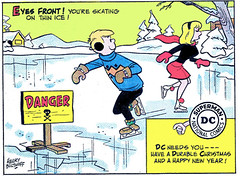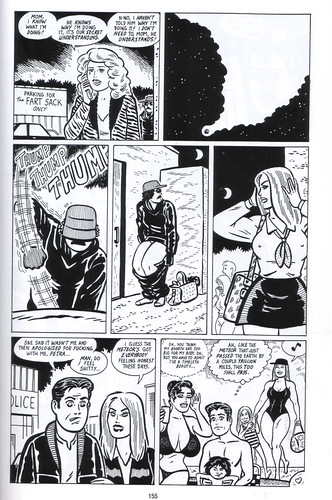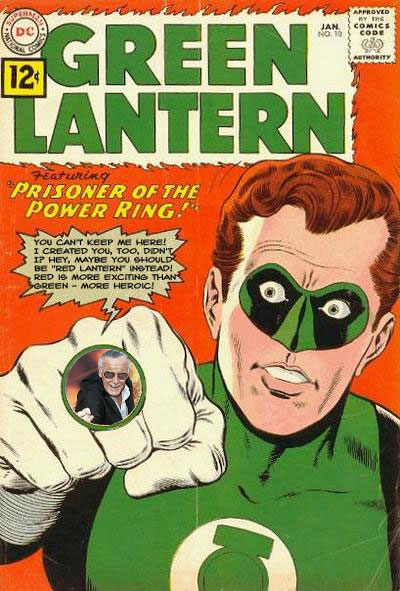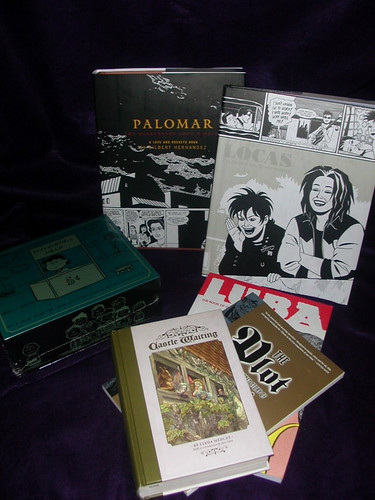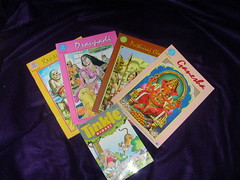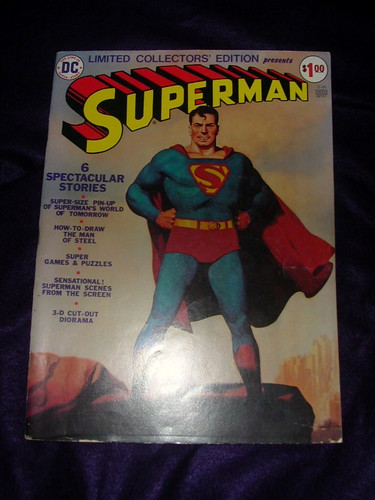Between holiday visitors and visiting and a boatload of student papers to read, there is no post this weekend.
On the bright side, Wonder Woman #3 finally came out, and they are still saying people's names with logo-lettering! Wonder Man indeed!
Best of all, it snowed in my part of the world!
Enjoy.
A rumination on rumination
This week, I have been making by way through Locas and Luba: The Book of Ophelia (both graciously provided by a Generous Benefactor). I was comparing the work of each hermano Hernandez in my mind; I am a little partial to Jaime over Gilbert, although I think they are both masterful. I noticed a difference in their narrative style, and thought that it might be that Gilbert used more unmarked scene-to-scene panel transitions (type 4 in Scott McCloud's closure schema). Here, take a look:
The first transition is type 4, from the ex-girlfriend to a meteor in space (that had been a constant metaphor in the story); this transitions to the next sequence of three panels, which have close to action-to-action (type 2) transitions as the new girlfriend (in drag) beats up the ex and changes back to regular clothes; then there's a type 4 transition to an explanatory scene; then a type 4 transition to a denouement scene.
What is interesting to me is than none of these transitions are assisted by captions; there's no "The next day" or "Later..." to help the reader out. There's sometimes visual help - you can see the disguised assailant in the background of the first panel - but overall, Gilbert's style requires a lot of engagement and attention to detail on the part of the reader, who must note clothing changes, background changes, subtleties of dialogue, and other specifics to determine the movement through time and place in the story, and to make sense of the plot. McCloud would say that the reader is required to add a lot of closure.
I'm not sure where I will be going with this analysis; I suppose with both Locas and Palomar at hand I could do a substantial quantitative analysis of panel transitions for each brother, and see if that makes meaning happen. What I thought was more interesting, perhaps, was that I couldn't remember the numbering in McCloud's scheme, so I pulled out my copy of Understanding Comics. While I found the information in a heartbeat, it took me about a half-hour to finally pull myself out of the book: I was re-reading it yet again. Of course, I then dipped into Locas and Luba to look for a sample page or two. There went another half-hour, as I read a story I hadn't yet gotten to. So I guess the upshot is that if I am going to do a formal analysis of this stuff, I had better block out a lot of time.
*The original story actually included a footnote to the word android and explained that it referred to "an artificial human being, made in a laboratory."
The first transition is type 4, from the ex-girlfriend to a meteor in space (that had been a constant metaphor in the story); this transitions to the next sequence of three panels, which have close to action-to-action (type 2) transitions as the new girlfriend (in drag) beats up the ex and changes back to regular clothes; then there's a type 4 transition to an explanatory scene; then a type 4 transition to a denouement scene.
What is interesting to me is than none of these transitions are assisted by captions; there's no "The next day" or "Later..." to help the reader out. There's sometimes visual help - you can see the disguised assailant in the background of the first panel - but overall, Gilbert's style requires a lot of engagement and attention to detail on the part of the reader, who must note clothing changes, background changes, subtleties of dialogue, and other specifics to determine the movement through time and place in the story, and to make sense of the plot. McCloud would say that the reader is required to add a lot of closure.
I'm not sure where I will be going with this analysis; I suppose with both Locas and Palomar at hand I could do a substantial quantitative analysis of panel transitions for each brother, and see if that makes meaning happen. What I thought was more interesting, perhaps, was that I couldn't remember the numbering in McCloud's scheme, so I pulled out my copy of Understanding Comics. While I found the information in a heartbeat, it took me about a half-hour to finally pull myself out of the book: I was re-reading it yet again. Of course, I then dipped into Locas and Luba to look for a sample page or two. There went another half-hour, as I read a story I hadn't yet gotten to. So I guess the upshot is that if I am going to do a formal analysis of this stuff, I had better block out a lot of time.
:::::::::::::::::::::::::::::::::::::::::::::::::::::::::::::::
With all the obscure characters showing up in 52 (not that I'm buying it, mind you, just reading blogs), I just wanted to throw in my nominations for resurrection, The Protectors of Starzl:
Terrane, Ocana, and Etheran originally appeared in Justice League of America #18 (March, 1963); their story was reprinted in Giant JLA #93 in October 1971. After neutralizing the League, these dudes were eventually beaten by Snapper Carr, because their invincibility was based on hyped-up autosuggestion rather than the actual magnitude of their powers. I still always thought they were pretty cool, even if they were androids*.
Here they are calling out the League, and calling for a revival:
Terrane, Ocana, and Etheran originally appeared in Justice League of America #18 (March, 1963); their story was reprinted in Giant JLA #93 in October 1971. After neutralizing the League, these dudes were eventually beaten by Snapper Carr, because their invincibility was based on hyped-up autosuggestion rather than the actual magnitude of their powers. I still always thought they were pretty cool, even if they were androids*.
Here they are calling out the League, and calling for a revival:
*The original story actually included a footnote to the word android and explained that it referred to "an artificial human being, made in a laboratory."
A short wait for a long "Waiting"
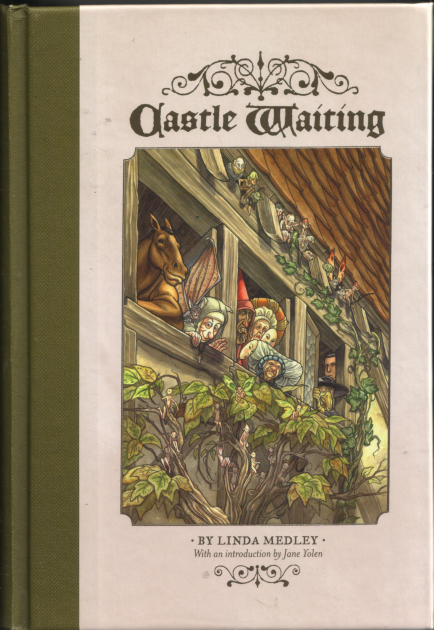
Castle Waiting
Linda Medley
Fantagraphics Books, 2006
Linda Medley
Fantagraphics Books, 2006
A few weeks ago, as I was browsing the graphic books section of my local excellent new-and-used bookstore, I came across an item of which I had heard nothing: a smallish (5.5 x 8 in) hardcover volume by Linda Medley called Castle Waiting. It appeared to be a retelling of the Sleeping Beauty story in beautiful clear-line comics format.
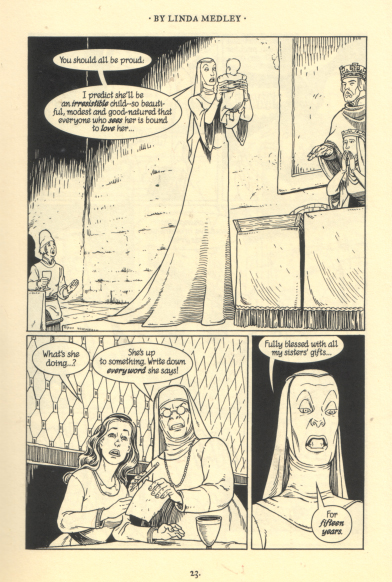
I got lost in the book for a good twenty minutes before being roused by my companion. I didn't pick the book up then, but put it on my buy-list. Not long ago, I was given a copy (along with numerous other Neat Stuff) by a Generous Benefactor, and now, having read the whole book, I can say that it is both more and less than I had anticipated.
The qualities that attracted me to the book in the first place did not disappoint. The art is attractive, with a direct and straightforward storytelling style using beautiful images; the comics equivalent of a Clint Eastwood-directed movie. For the most part, the writing matches the excellence of the art; the dialogue is natural without being anachronistic, the characters are well-realized and consistent, and even the throwaway bits are amusing (such as a background song about Queen Dinah Saurus).
The Sleeping Beauty story turns out just to be the set-up; after introducing all the familiar elements - the curse, the ban on spinning in the Kingdom, the pricked finger, the deep sleep, the barrier of thorns - Castle Waiting dispenses with the rest of the story - the 100-year coma, rescue, and departure of the princess - in about six pages. What the book is really about is the castle itself, which becomes a sort of refuge for a collection of oddball characters unable to fit in with the outside world.
The world in which Medley situates the castle is an odd but beguiling one. It is that sort of vaguely European, vaguely medieval world that is the favorite of many fantasy writers. This particular version is peopled not only with fairy tale types, like Beauty and Ruplestilskin, but with some anthropomorphic animals, as well - usually innkeepers and tradesmen are humans, but sometimes they are cats or bears, with no explanation given. The steward of the castle is a stork and one of the guests is a knight who is a horse - but they ride together in an ox cart.
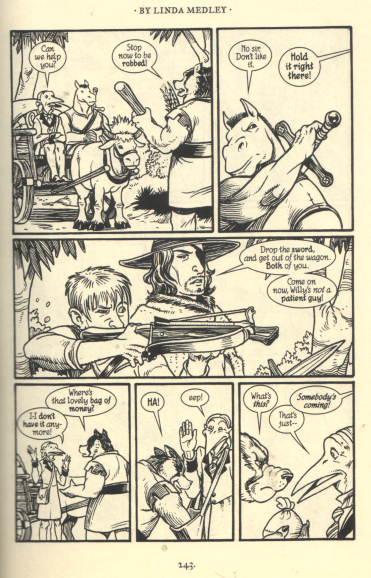
The end result is a bit jarring at times; since characters hunt and fish, I wonder how they distinguish between people-animals and animal-animals, but maybe that's just me.
Worlds blend in other ways. In an early adventure, the nominal protagonist Jain gets involved with both some Gypsies and what appear to be some Hobbits, and despite the unspecified setting of the story, references are made to Saint Wilgefortis, a historical (although fictional) Catholic martyr from the 15th century. There are also references to characters I feel I should know (or might have known) from other traditions, but I couldn't quite place them.
Most of the time, the "continuity" issues aren't a concern, since the characters are so compelling. Castle Waiting is peopled by men and women and animals (but mostly women) who are intelligent and aware and well-intentioned and flawed and noble and real. There's conflict in the story, but violence is not the solution of first resort, and many problems are solved by reason and creativity rather than fighting (although the horse-knight, Sir Chess, does knock some blackguards around). This book is full of good role models for children, young girls in particular.
As much as I enjoyed the story, which follows the arrival of Jain at the castle, the birth of her child, and her initial interactions with the rest of the residents, I have the same quibble with the book as some other reviewers did: about halfway through, just when the reader is getting comfortable with the characters, one of them begins to tell a story in an extended flashback - which has another extended flashback story in it - for just about the rest of the book. This complete shift away from the cast of characters, who all but disappear except for vignettes setting up the storytelling, is at best confusing and more than a little disappointing. Since the book is a collection of an ongoing series, it might have been a better to break it into two volumes, with a framing sequence for each.
In the end, it's really a rather small problem with the book; Castle Waiting is well worth a place in your collection.
My cup runneth over
So, a bunch of stuff happened this week, providing me with lots of comics-related material; lots more, in fact, than I will be able to read for some time. And it was all at no cost to me! Sometimes you trip over a pot of gold, and there isn't even a rainbow around.
First of all, Big Brown delivered a neat and tidy box the other day. Beneath all the packing peanuts was this treasure trove:
I will not announce whence came this munificence, to protect the modesty of my benefactor; I did want to offer a hearty and public thank-you nonetheless. I hope to have a chance to discuss some of these works here soon, but I'm afraid I'll be lost with Maggie and Hopey for some time.
But, as Ron Popeil would say - that's not all! Check this out:
I was discussing my upcoming composition class with some teaching colleagues, and describing how our source readings would all be graphic books. One instructor told me that she had some Indian comics, and offered to share them with me. I have read some about the Indian comics market, particularly recent deals with Richard Branson's Virgin conglomerate and the Spider-man India project from a couple years back, but I had never encountered homegrown Indian comics before. This stash comprises four issues of Amar Chitka Katha, which chronicles mythological, historical, and fictional adventure stories, and one copy of Twinkle Digest, aimed at younger children. I'll try to have interior scans of this stuff up soon.
But there is yet more! Look at this blast from the past:
On Halloween, a great and good friend (and the spiritual heir to Harry Houdini) came over and graced me with a copy of Limited Collector's Edition #3 from 1974, featuring a whole bundle of Superman stuff (for a buck!). Aside from being a big (14" x 10"), fun book, this looks to be a great primer to the development of the pre-CoIE Superman: it starts with a couple stories of the early Siegel and Schuster tough-guy Superman running and jumping and generally rushing all around to fight fascists and crooked politicians; continues with a Wayne Boring car-juggling Supes; gives us a Kurt Schaffenberger Krypto-and-Lois comedy and an Andru-Esposito "L.L." caper; and ends with a Curt Swan re-telling of the origin (complete with Kryptonian headbands). There's lots of extra features as well; I'll try to get some interior stuff, but it's almost too big to scan!
So, thanks to random generosity, my comics reading is stockpiled! Thanks to everyone (you know who you are) for sharing.
I must also admit that I added to my own pile as well, picking up all the issues of 52 that had come out since I had forsworn the series a couple of months ago. I fell off the wagon because I was enticed by all the talk on the internets of Will Magnus and mad scientists and the Metal Men. Well, it really wasn't worth it. The throwaway bits are great fun, and some of them are genius; the puzzle aspect of the series is pretty cool; but overall, it's just not engaging as story. It's still a big ol' mess, the plots are moving along way too slowly, some of the guest shots look like pure promotion rather than story elements, and I have no confidence that I will understand any eventual denouement anyway. I'm done, for real this time.
Now, I heard a rumor that Lady Cop is coming back in the pages of The Atom...
First of all, Big Brown delivered a neat and tidy box the other day. Beneath all the packing peanuts was this treasure trove:
LOCAS hardcover by Jaime Hernandez
Palomar hard cover by Gilbert Hernandez
Luba: Book of Ofelia softcover by Gilbert Hernandez
The Plot softcover by Will Eisner
Castle Waiting hardcover by Linda Medley
(this one was a particular surprise, since I had just discovered it at a bookstore,
moving it to the top of my buy list after being lost in it for a half-hour)
and
The slipcased, hardcover, first two volumes of The Complete Peanuts
(covering 1959 to 1962)
Palomar hard cover by Gilbert Hernandez
Luba: Book of Ofelia softcover by Gilbert Hernandez
The Plot softcover by Will Eisner
Castle Waiting hardcover by Linda Medley
(this one was a particular surprise, since I had just discovered it at a bookstore,
moving it to the top of my buy list after being lost in it for a half-hour)
and
The slipcased, hardcover, first two volumes of The Complete Peanuts
(covering 1959 to 1962)
I will not announce whence came this munificence, to protect the modesty of my benefactor; I did want to offer a hearty and public thank-you nonetheless. I hope to have a chance to discuss some of these works here soon, but I'm afraid I'll be lost with Maggie and Hopey for some time.
But, as Ron Popeil would say - that's not all! Check this out:
I was discussing my upcoming composition class with some teaching colleagues, and describing how our source readings would all be graphic books. One instructor told me that she had some Indian comics, and offered to share them with me. I have read some about the Indian comics market, particularly recent deals with Richard Branson's Virgin conglomerate and the Spider-man India project from a couple years back, but I had never encountered homegrown Indian comics before. This stash comprises four issues of Amar Chitka Katha, which chronicles mythological, historical, and fictional adventure stories, and one copy of Twinkle Digest, aimed at younger children. I'll try to have interior scans of this stuff up soon.
But there is yet more! Look at this blast from the past:
On Halloween, a great and good friend (and the spiritual heir to Harry Houdini) came over and graced me with a copy of Limited Collector's Edition #3 from 1974, featuring a whole bundle of Superman stuff (for a buck!). Aside from being a big (14" x 10"), fun book, this looks to be a great primer to the development of the pre-CoIE Superman: it starts with a couple stories of the early Siegel and Schuster tough-guy Superman running and jumping and generally rushing all around to fight fascists and crooked politicians; continues with a Wayne Boring car-juggling Supes; gives us a Kurt Schaffenberger Krypto-and-Lois comedy and an Andru-Esposito "L.L." caper; and ends with a Curt Swan re-telling of the origin (complete with Kryptonian headbands). There's lots of extra features as well; I'll try to get some interior stuff, but it's almost too big to scan!
So, thanks to random generosity, my comics reading is stockpiled! Thanks to everyone (you know who you are) for sharing.
I must also admit that I added to my own pile as well, picking up all the issues of 52 that had come out since I had forsworn the series a couple of months ago. I fell off the wagon because I was enticed by all the talk on the internets of Will Magnus and mad scientists and the Metal Men. Well, it really wasn't worth it. The throwaway bits are great fun, and some of them are genius; the puzzle aspect of the series is pretty cool; but overall, it's just not engaging as story. It's still a big ol' mess, the plots are moving along way too slowly, some of the guest shots look like pure promotion rather than story elements, and I have no confidence that I will understand any eventual denouement anyway. I'm done, for real this time.
Now, I heard a rumor that Lady Cop is coming back in the pages of The Atom...
Subscribe to:
Posts (Atom)
